Myobrace® Permanent Dentition Class III Stage 2 - P-3
Arch expansion and continue habit correction in the permanent dentition
The P-3® focuses on arch development and continuing habit correction for Class III patients in the permanent dentition. It has small breathing holes to maintain continuous nasal breathing and myofunctional features to promote correct habits. The P-3® features a revolutionary Dynamicore™ inner cage for arch development to further improve habit correction. It also features MRC’s patented flat tongue tag to optimise tongue position and the 3mm offset to promote dental Class III correction. Move to the P-3H when the P-3® has corrected the arch form, breathing and myofunctional habits.
Design Features
The design features of the P-3® are suited to promote arch development while correcting breathing and myofunctional habits in Class III patients in the permanent dentition.
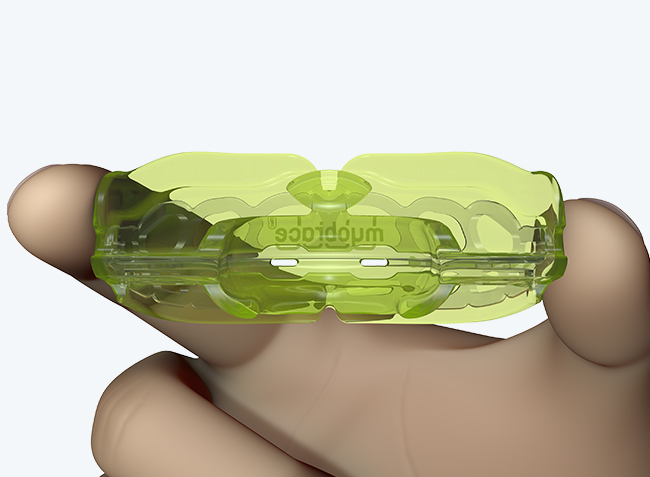
Firmer material
imparts extra force to promote arch development.
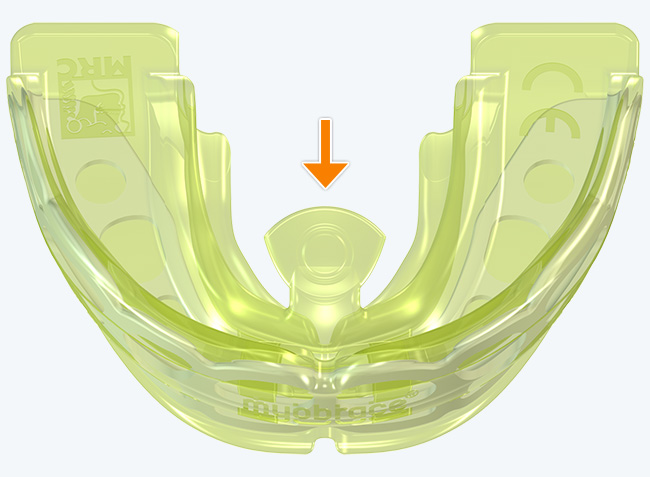
Flexible tongue tag
guides the tongue upwards and forwards into the correct position.
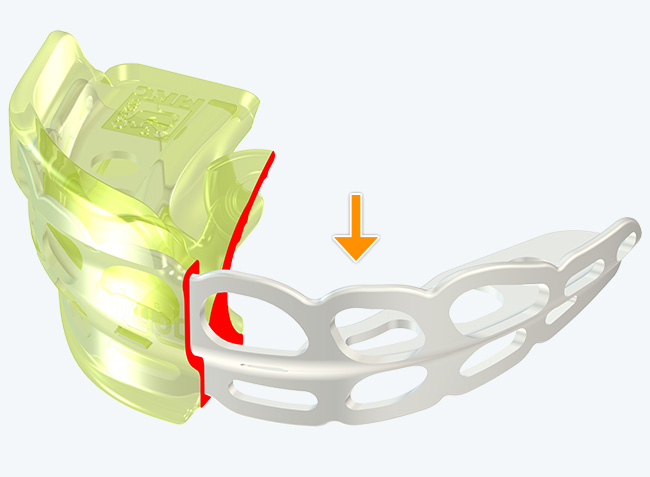
Dynamicore™ with Frankel Cage
to promote extra arch development.
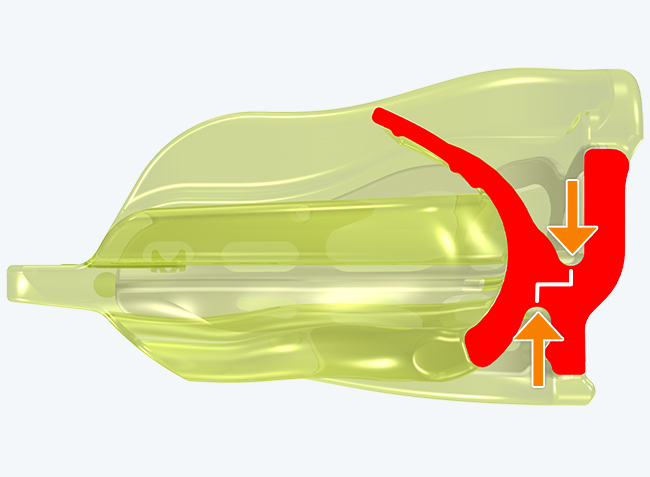
3mm offset
corrects the underbite by pushing upper teeth forward and lower teeth back.
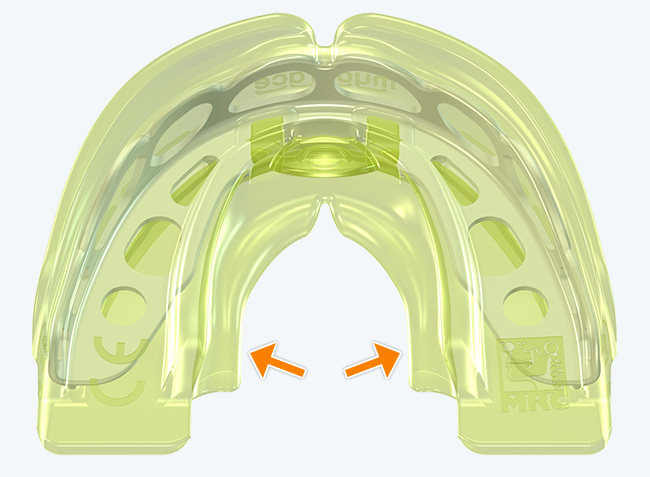
Tongue elevator
lifts the tongue into the correct position.
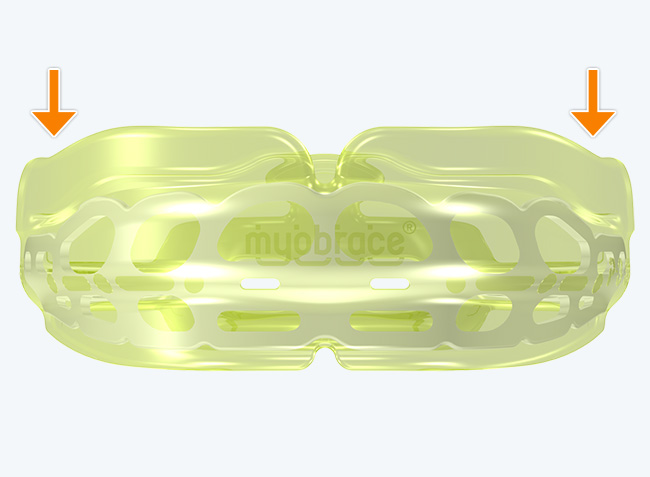
Frankel shields
for added upper arch development.
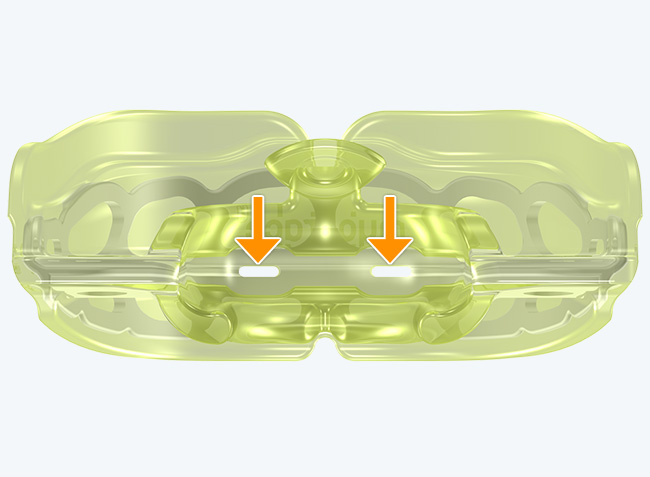
Breathing holes
encourage and establish nasal breathing.
Directions for Use
The Myobrace® appliance is to be used for one to two hours each day, plus overnight while sleeping. The patient's teeth may become slightly sensitive in the early stages of treatment. This is quite normal, however, if pain becomes excessive, decrease application time with the aim to build it back up once the appliance is accustomed to and sensitivity subsides.
Step 1
Hold the Myobrace® with the tongue tag facing up.
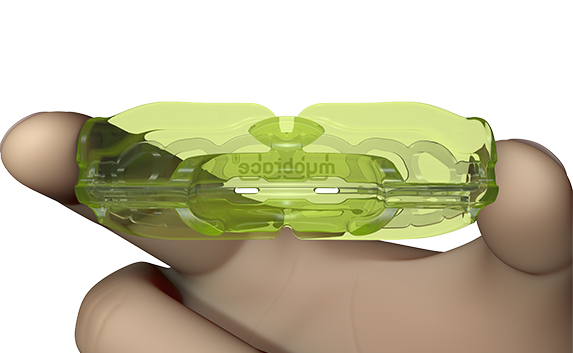
Step 2
Place the Myobrace® into your mouth.
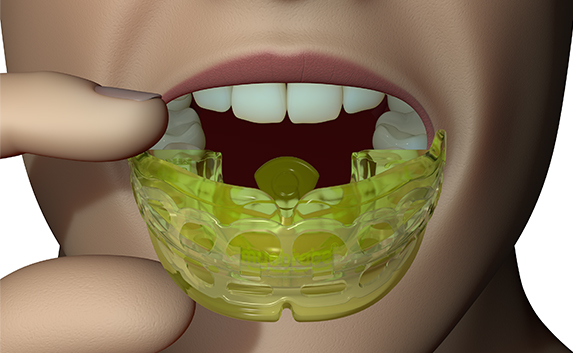
Step 3
Keep your tongue positioned on the tongue tag.
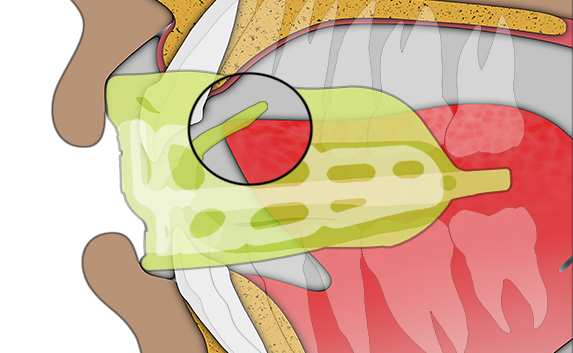
Step 4
Close down on the Myobrace® and feel it working to align your front teeth and jaws.
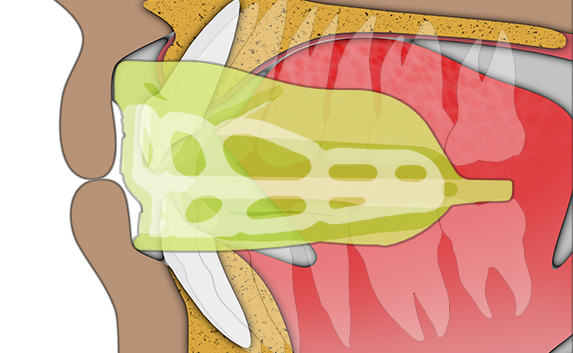
Step 5
Keep your lips together and breathe through your nose.
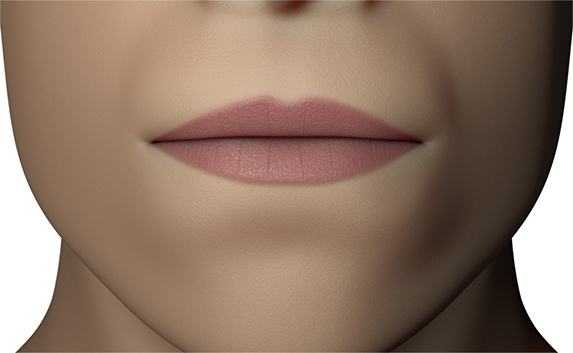
Cleaning the Appliance
The Myobrace® appliance should be cleaned under warm running water every time the patient removes it from their mouth.
Use Myoclean™ tablets to thoroughly clean twice a week. Myoclean™ is the recommended cleaning agent for all MRC appliances.
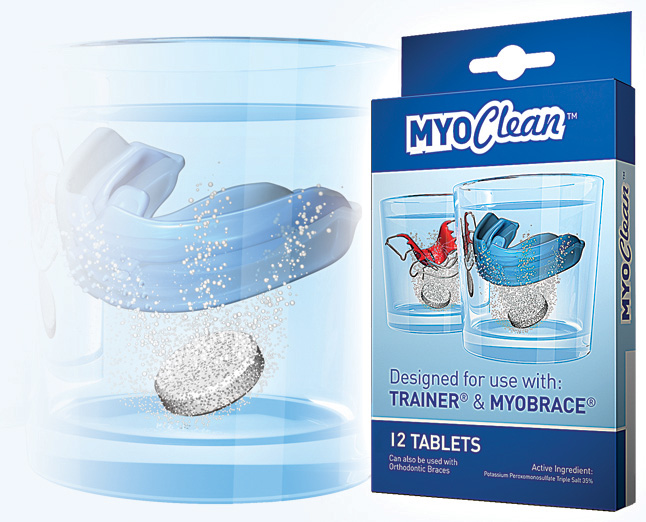
Case Studies
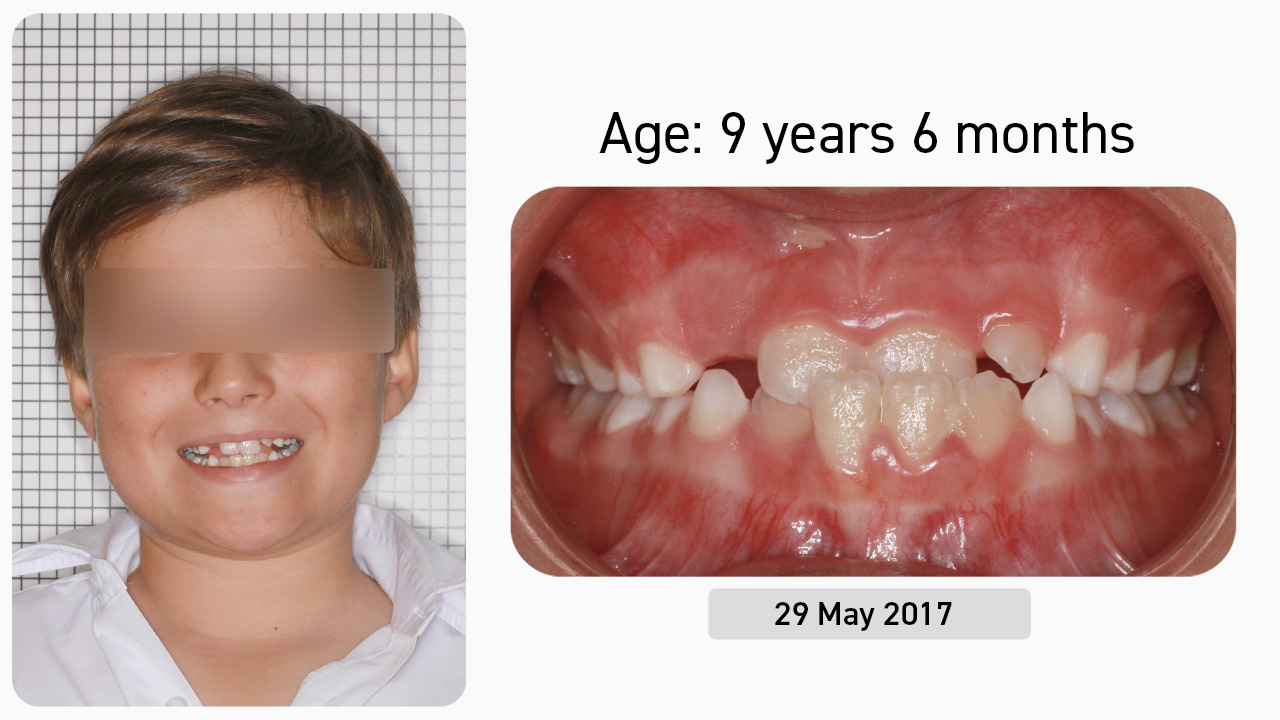
Case Study 1
This nine-year-old male patient presented with the chief complaint of an underbite and wanting to avoid braces. After being presented with the various treatment options, the decision was made to undertake Myobrace® treatment. This involved the use of a series of Myobrace® appliances combined with the Myobrace® Activities.
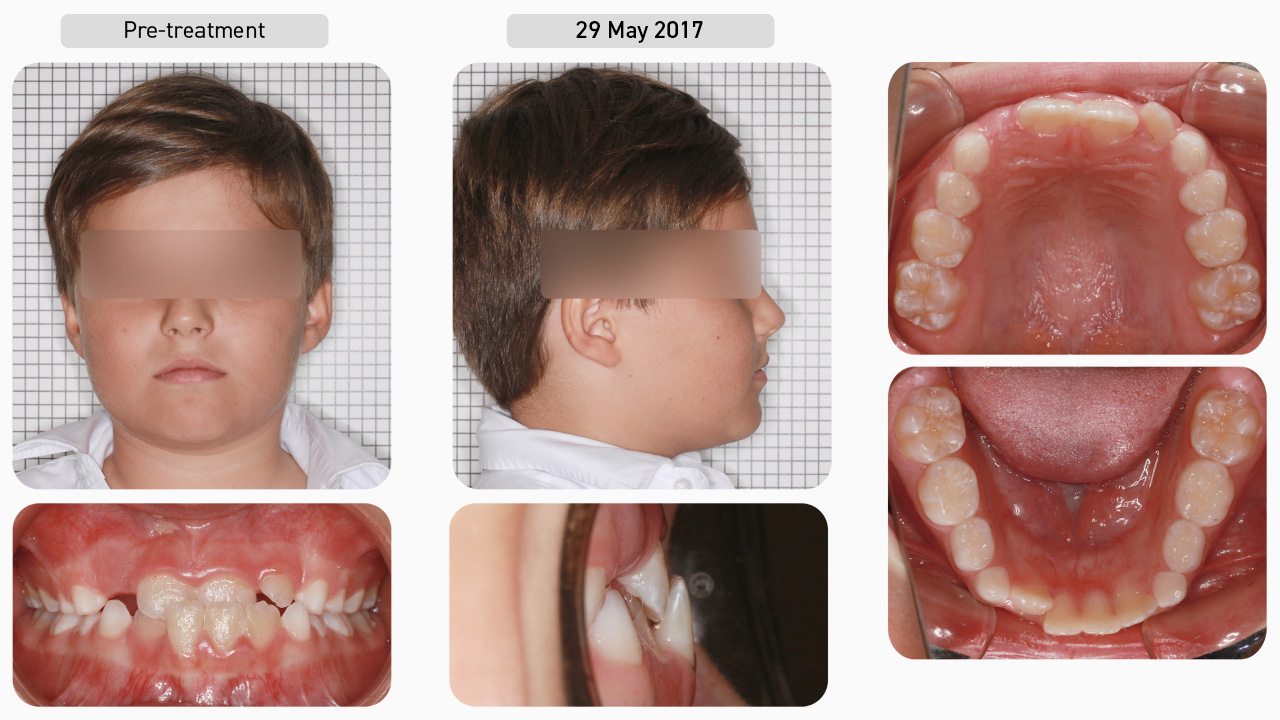
Pre-treatment
Using the Myofunctional Orthodontic Evaluation (MOE) form, we documented that this patient had a flattened upper arch with anterior crossbite and moderate dental crowding. This patient was a snorer and bruxer, and his poor myofunctional habits included mouth breathing with a low tongue posture and reverse swallow. Since he was in the mixed dentition with an anterior crossbite, his treatment began with the Interceptive Class III series.
Dental Progression
He started with the i-3N appliance to establish nasal breathing and begin the correction of myofunctional habits. Once his breathing function had improved and he was consistently retaining the i-3N overnight (which took longer than usual due to subpar compliance), he was issued the i-3® appliance to focus on arch development and continued habit correction. At this stage, we would ordinarily employ the use of the BWS arch expansion appliance to enhance upper arch development and create space in the roof of the mouth to comfortably rest the tongue. However, it was at this stage that the patient's mother informed us that she did not want us to use anything that involved placing metal in the mouth, making the BWS (along with all other traditional arch expansion appliances) no longer an option. The decision was then made to use the P-3® appliance with absolute patient compliance to get as much improvement as possible, with the understanding that without the BWS, treatment would be compromised. The P-3® appliance was chosen because of its high reaching Frankel shields and because it is a firmer and more robust appliance than the i-3®.
Dental Progression
Good compliance with both Myobrace® wear and the Myobrace® Activities saw the upper arch slowly develop forward and the anterior crossbite resolve. The patient started with a medium P-3® appliance and, as the jaws developed, progressed onto the large P-3®. Notice the small spaces that have opened up mesial to the upper deciduous canines without the use of the BWS. This is because the upper arch has developed as a result of good function. These 'extra' spaces are needed to accommodate the soon to erupt permanent canines.
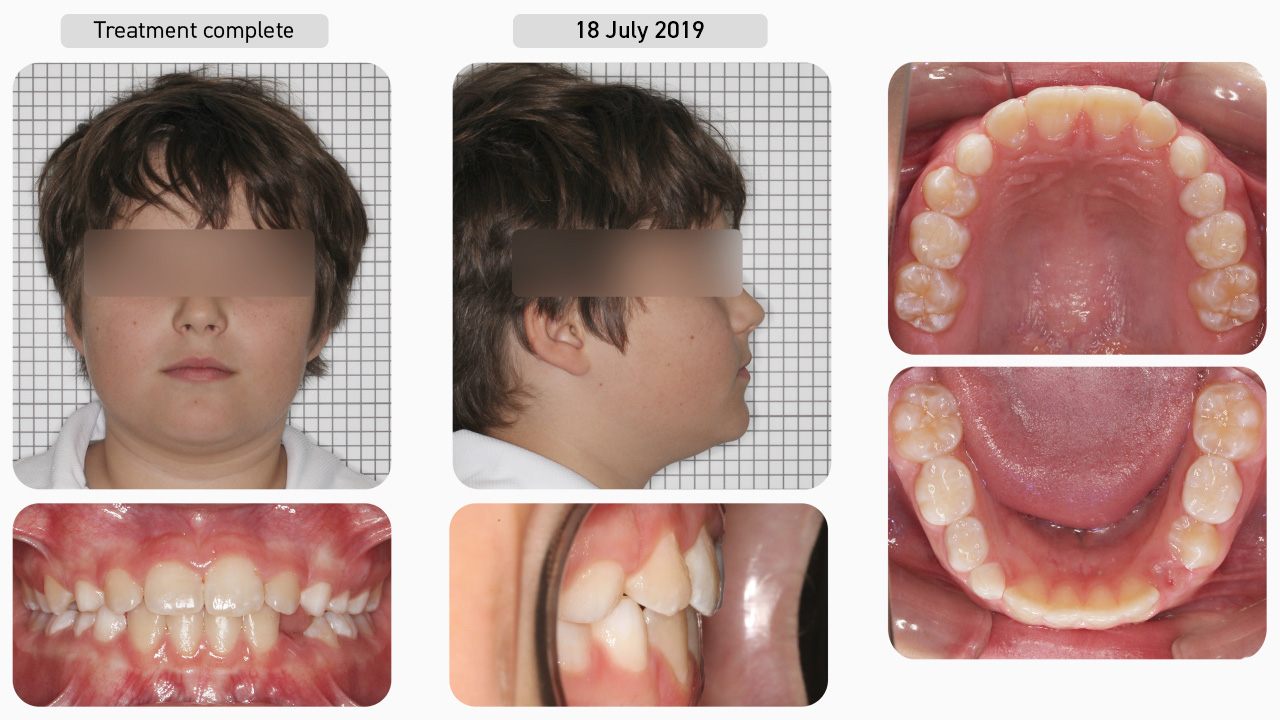
Treatment Complete
With good compliance, the goals of Myobrace® treatment were achieved, these were to establish nasal breathing, correct the myofunctional habits and attain good arch forms. The patient was then entered into the retention phase, continuing on the P-3® appliance to retain the arch forms, alignment and habits, ensuring that he could continue to develop correctly.
Facial Progression
With the breathing and myofunctional disorders having been corrected, the teeth not only aligned, but the airway improved and the patient was no longer snoring or bruxing. One year on, and the result has not only been maintained, but has continued to improve. With good breathing and muscle function established, we expect the patient’s remaining development to continue in a favourable manner.
Treatment Summary
Although we were unable to utilise BWS arch expansion in this case due to the parent being opposed to metal in the mouth, using the Myobrace® appliances in conjunction with the Myobrace® Activities, we have helped the patient to establish nasal breathing, correct his myofunctional habits and, therefore, achieve natural alignment of the teeth and correction of the anterior crossbite while establishing well-rounded arches. With the correct breathing and muscle habits maintained, we can expect further improvements in the teeth and jaws as the patient continues to grow.
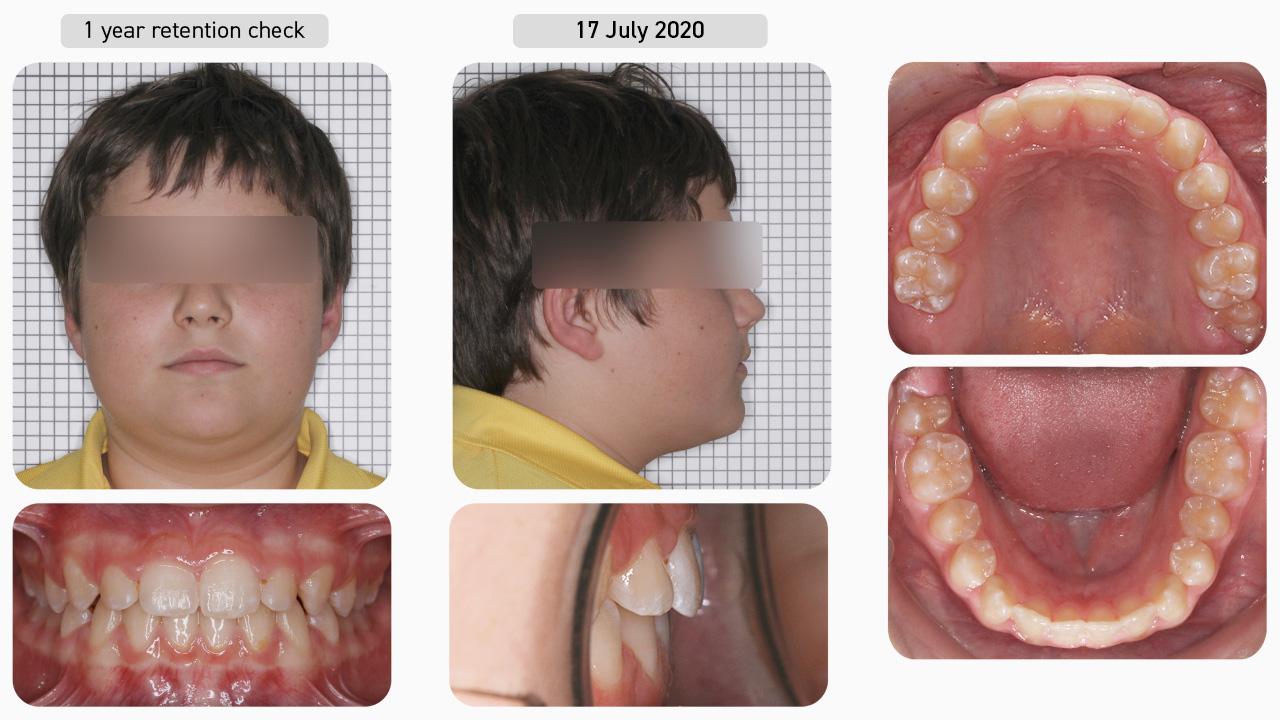
Retention
One year later, the result achieved has been maintained without the use of fixed retainers and, in fact, has improved with his continued use of the P-3® appliance. With correct breathing and myofunctional habits sustained, we expect this to continue further going forward.

Case Study 2
This nine-year-old female patient presented with the chief complaint of crowded and crooked teeth and was seeking a second opinion as she did not want braces and extractions. After being presented with the various treatment options, the decision was made to undertake Myobrace® treatment. This involved the use of Myobrace® appliances, in conjunction with the BWS arch expansion appliance, and the Myobrace® Activities.

Pre-treatment
Using the Myofunctional Orthodontic Evaluation (MOE) form, we documented that this patient had underdeveloped upper and lower jaws with severe dental crowding. Both the upper and lower arches were narrow and flattened anteriorly, and there was lost space for the lower left canine tooth. There was also a deep bite and increased overjet present, and her poor myofunctional habits included mouth breathing with low tongue posture and a reverse swallow. Since the patient was in the mixed dentition, her treatment began with the Myobrace®for Kids series.
Dental Progression
She started with the K1 appliance to establish nasal breathing and begin the correction of myofunctional habits. Two months later, her breathing function had improved, and she was consistently retaining the K1 overnight, so she was issued the K2 appliance to focus on arch development and continued habit correction. There was a noticeable reduction in overbite and overjet after only two months of treatment. The decision was then made to use the BWS arch expansion appliance to enhance upper arch development. The BWS must be combined with a first stage appliance, so the patient was issued the T1 appliance now that she was in the developing permanent dentition. Notice how the space for the initially blocked out lower left canine has started to open up without the use of any fixed appliances or any expansion appliances in the lower arch. This is the result of correcting the breathing and myofunctional disorders, thereby normalising growth and allowing the jaws to develop to their fullest potential.
Dental Progression
Once upper arch expansion was complete, the wire was removed and the patient was reissued the K2 appliance, this time in a large size. A few months later, the patient was upgraded to the T2, as this appliance is better suited to the developing permanent dentition. Approximately one year after the first round of expansion, the decision was made to enter a second round of BWS expansion. So, the BWS was refit, and the patient was reissued the T1 appliance.
Dental Progression
Following the second round of BWS expansion, the wire was again removed and the patient was issued the P-3® appliance. Note the temporary anterior open bite that has developed during BWS expansion. With good function, this is expected to close within a few months, as can be seen in the treatment progress photos.
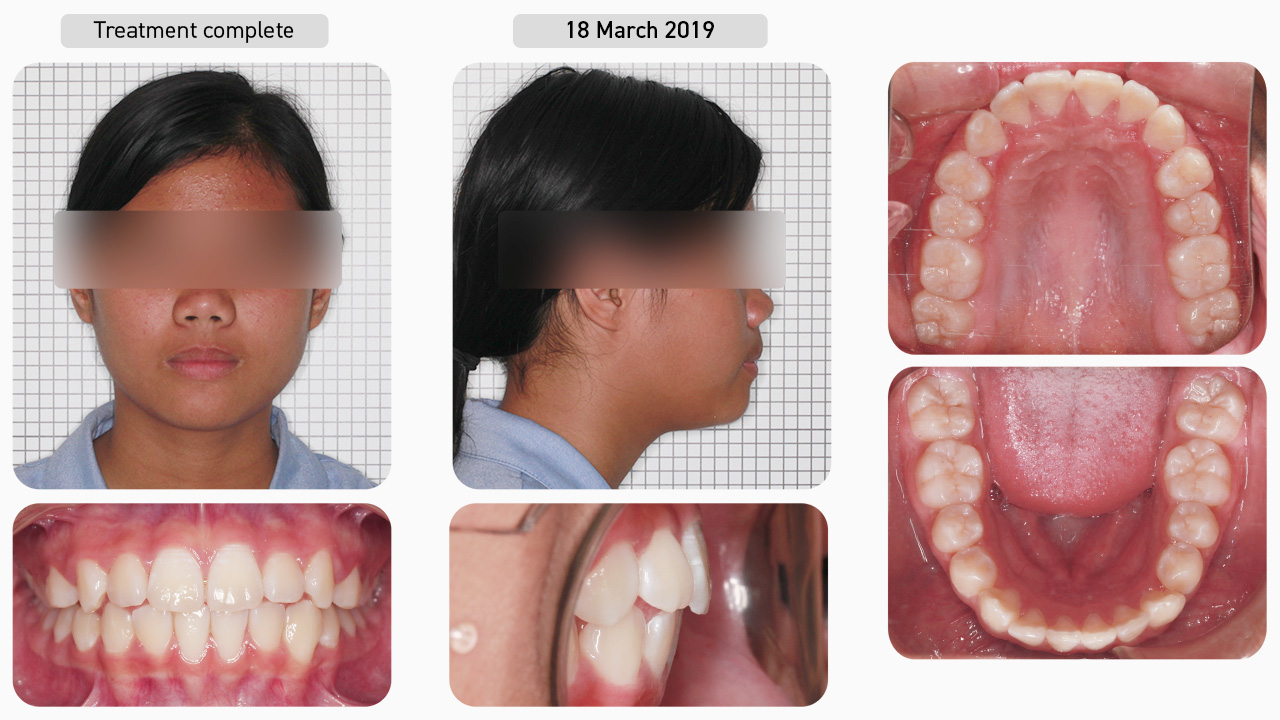
Treatment Complete
After two years, the goals of Myobrace® treatment had been achieved. Nasal breathing was established, poor myofunctional habits corrected and arch forms improved. The continued use of the P-3® became her retention appliance in order to retain the arch forms, alignment and correct habits, so that she can continue to develop correctly into the future.
Facial Progression
With the breathing and myofunctional disorders corrected, not only have the teeth and jaws aligned, but improvements can be seen in the development of the face. In particular, the direction of growth has changed from vertical to a more horizontal growth, and this is reflected in the facial profile. With good breathing and muscle function established, we expect the patient’s remaining development to continue in a favourable manner.
Treatment Summary
Using the Myobrace® appliances in conjunction with BWS arch expansion and the Myobrace® Activities, we have helped the patient to establish nasal breathing, correct her myofunctional habits and, therefore, achieve natural alignment of the teeth. The arch forms have improved significantly, and the deep bite and increased overjet have resolved. Notably, space has been gained for the initially blocked out lower left canine, and the patient has successfully avoided fixed braces and extractions. Although the alignment of the lower left canine is not perfect, it is important to understand that in Myobrace® treatment we are not concerned with dental ‘perfection’ as we are seeking natural alignment of the teeth, which occurs in conjunction with habit correction. With the correct breathing and muscle habits maintained, we expect the patient to continue improving in their dental development and good stability of the results.
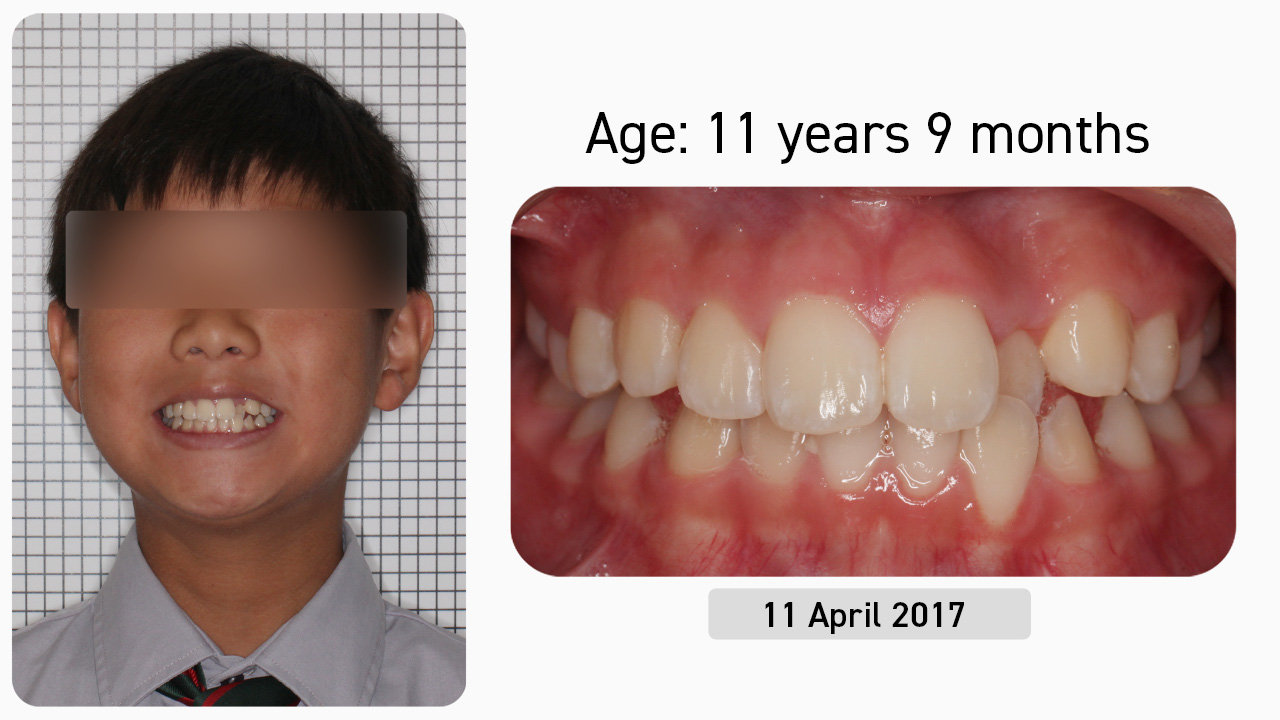
Case Study 3
This 11-year-old male patient presented with the chief complaint of crowded, crooked teeth and difficulty chewing. After being presented with the various treatment options, the decision was made to undertake Myobrace® treatment. This involved the use of Myobrace® appliances, in conjunction with the BWS arch expansion appliance, and the Myobrace® Activities.
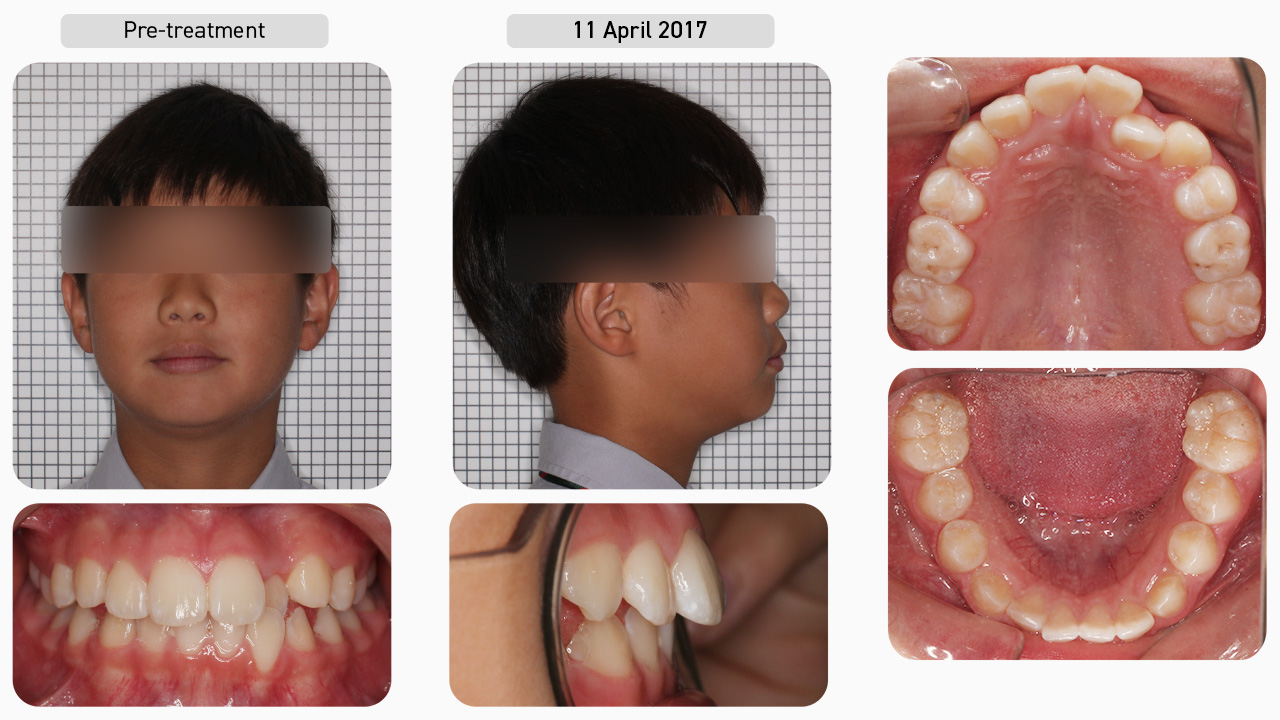
Pre-treatment
After conducting a Myofunctional Orthodontic Evaluation (MOE), we discovered that this patient had mild dental crowding with an instanding upper lateral incisor in crossbite. As a result, the patient experienced difficulty chewing on the left-hand side. His poor myofunctional habits included mouth breathing with low tongue posture and a reverse swallow. Since the patient had a developing permanent dentition, his treatment began with the Myobrace® for Teens series.
Dental Progression
The patient was first issued the T1 appliance to establish nasal breathing and begin the correction of myofunctional habits. Six weeks later, his breathing function had improved and he was consistently retaining the T1 overnight, so he progressed onto the T2 appliance to focus on arch development and continued habit correction. The arch forms and dental alignment were improving, however, three months later, he developed an anterior edge-to-edge occlusion, so the P-3® appliance was issued as it has more incisal offset.
Dental Progression
A few months later, the decision was made to use the BWS arch expansion appliance to help develop the upper arch and move the instanding lateral incisor forward. This patient needed multiple rounds of expansion, so the wire was removed for a few months to allow the teeth to settle before refitting the wire for a second round of expansion. Once BWS expansion was complete, the wire was removed and a few months later, once function was largely corrected, the patient was issued the T4 appliance for retention.
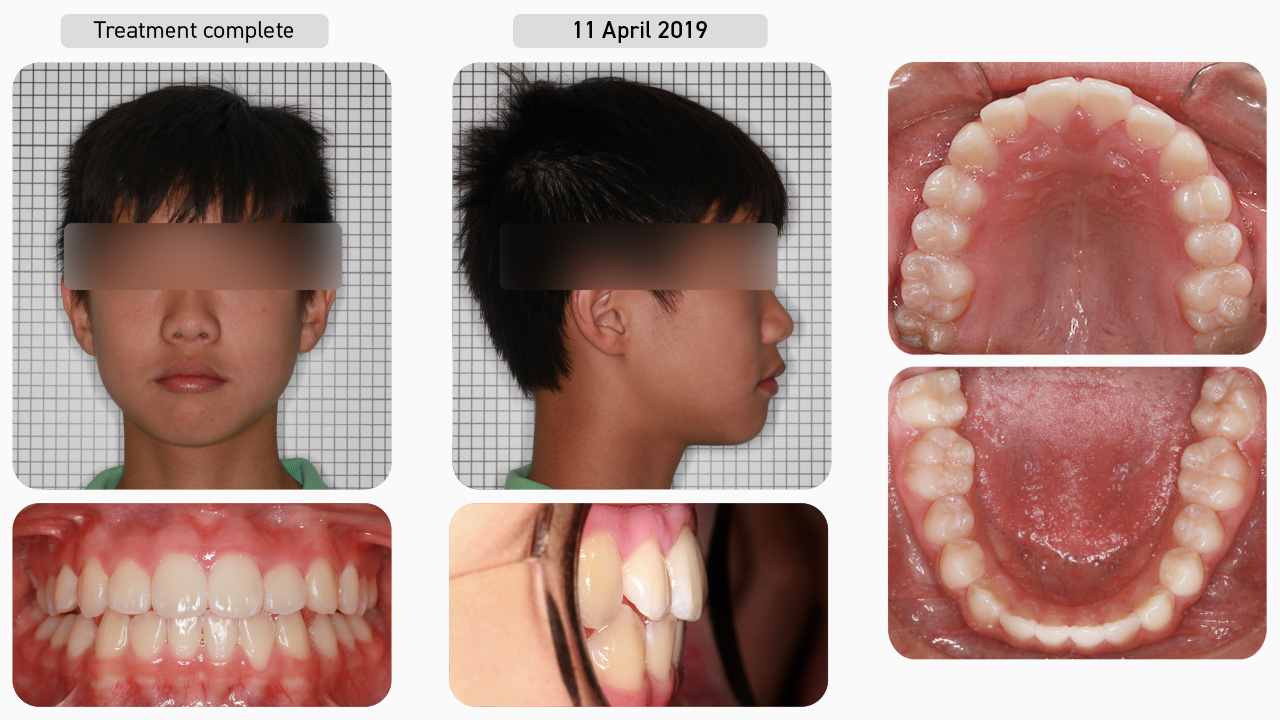
Treatment Complete
After two years of treatment, the goals of Myobrace® treatment were achieved, which are to establish nasal breathing, correct the poor myofunctional habits and improve the arch forms, so the patient was entered into the retention phase of treatment. The T4 appliance was issued to retain the arch forms, alignment and correct habits, allowing him to continue developing correctly.
Facial Progression
With the breathing and myofunctional disorders corrected, improvements can be seen in the development of the face. In particular, the direction of growth has changed from vertical to more horizontal, which is reflected in the facial profile. With good breathing and muscle function established, we expect the patient’s remaining development to continue in a favourable manner as time goes on.
Treatment Summary
Using the Myobrace® appliances in conjunction with BWS arch expansion and the Myobrace® Activities, we have helped the patient to establish nasal breathing, correct his myofunctional habits and, therefore, achieve natural alignment of the teeth. The arch forms have improved, the teeth are well aligned, and the anterior crossbite has been corrected. In Myobrace® treatment, we are not concerned with dental ‘perfection’ as we are looking for natural alignment, occurring with habit correction. With the correct breathing and myofunctional habits maintained, we expect the patient to continue improving in their dental development and good stability of the results into the future.
Resources
Appliance Instructions
Downloadable pdf document with instructions specifically for the P-3®.
Download ResourceMyobrace® Appliance Catalogue
Downloadable pdf document detailing the Myobrace® appliance range.
Download Resource